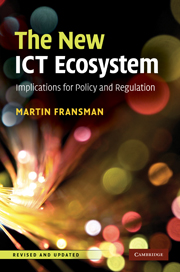Book contents
- Frontmatter
- Contents
- List of exhibits
- Preface
- List of abbreviations and acronyms
- Introduction
- 1 Summary of the argument
- 2 The new ICT ecosystem: architectural structure
- 3 The new ICT ecosystem as an innovation system
- 4 The new ICT ecosystem: a quantitative analysis
- 5 Telecoms regulation
- 6 Policy-making for the new ICT ecosystem
- 7 The way forward: the message to policy-makers and regulators
- Appendixes
- Bibliography
- Index
6 - Policy-making for the new ICT ecosystem
Published online by Cambridge University Press: 04 May 2010
- Frontmatter
- Contents
- List of exhibits
- Preface
- List of abbreviations and acronyms
- Introduction
- 1 Summary of the argument
- 2 The new ICT ecosystem: architectural structure
- 3 The new ICT ecosystem as an innovation system
- 4 The new ICT ecosystem: a quantitative analysis
- 5 Telecoms regulation
- 6 Policy-making for the new ICT ecosystem
- 7 The way forward: the message to policy-makers and regulators
- Appendixes
- Bibliography
- Index
Summary
Governments can, and in the author's view should, monitor and benchmark the performance of their new ICT ecosystem–innovation system (NIE–IS). (As this chapter primarily concerts systems, we shall use the acronym ‘NIE’ for ‘new ICT ecosystem’ and ‘IS’ for ‘innovation system’ here.) Government should regularly publish and publicise what their performance objectives for the national NIE–IS are, and how actual performance compares with the best in the world and with other comparable NIE–ISs. This will serve to focus attention on what should be done.
Policy-making at the national and regional level
How should policy-makers go about the task of making policy for the NIE? The aim of this chapter is to put forward some suggestions in answer to this question. But first it is necessary to say something about policy-making at national and regional levels.
In this book we have been concerned with the evolving NIE and the way in which it has changed over time. In chapter 3 it was shown that innovation – that is, new products/services, new technologies and processes, new forms of organisation and new markets – drives the evolution of the NIE. It was suggested, further, that each NIE contains an innovation system (IS) which generates the innovations. In this chapter reference will be made to the NIE and its innovation system, NIE–IS.
Each country has a NIE–IS. However, the NIE–IS in each country is different. One reason why NIE–ISs differ is international competitiveness.
- Type
- Chapter
- Information
- The New ICT EcosystemImplications for Policy and Regulation, pp. 86 - 101Publisher: Cambridge University PressPrint publication year: 2010



